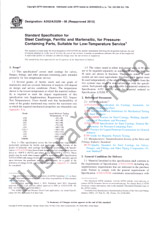Potřebujeme váš souhlas k využití jednotlivých dat, aby se vám mimo jiné mohly ukazovat informace týkající se vašich zájmů. Souhlas udělíte kliknutím na tlačítko „OK“.
ASTM D7542-21
Standard Test Method for Air Oxidation of Carbon and Graphite in the Kinetic Regime
Přeložit název
NORMA vydána dne 1.11.2021
Informace o normě:
Označení normy: ASTM D7542-21
Datum vydání normy: 1.11.2021
Kód zboží: NS-1043807
Počet stran: 13
Přibližná hmotnost: 39 g (0.09 liber)
Země: Americká technická norma
Kategorie: Technické normy ASTM
Kategorie - podobné normy:
Anotace textu normy ASTM D7542-21 :
Keywords:
activation energy, air, carbon, graphite, kinetic regime, oxidation rate, pre-exponential factor, standard oxidation temperature, temperature,, ICS Number Code 71.060.10 (Chemical elements)
Doplňující informace
| Significance and Use | ||||||||||
|
5.1?This test method can be used to measure the rate of oxidation for various grades of manufactured carbon and graphite in standard conditions, and can be used for quality control purposes. 5.2?The following conditions are standardized in this test method: size and shape of the graphite specimens; their placement in the vertical furnace with upwards air flow; the method for continuous weight variation measurement using an analytical scale with under-the-scale port; the air flow rate, which must be high enough to ensure that oxidation is not oxygen-starved at the highest temperature used; the initial and final points on the weight loss curve used for calculation of oxidation rate. 5.3?This test method also provides kinetic parameters (apparent activation energy and logarithm of pre-exponential factor) for the oxidation reaction, and a standard oxidation temperature. The results characterize the effect of temperature on oxidation rates in air, and the oxidation resistance of machined carbon or graphite specimens with standard size and shape, in the kinetic, or chemically controlled, oxidation regime. This information is useful for discrimination between material grades with different impurity levels, grain size, pore structure, degree of graphitization, or antioxidation treatments, or a combination thereof. 5.4?Accurately determined kinetic parameters, like activation energy and logarithm of pre-exponential factor, can be used for prediction of oxidation rates in air as a function of temperature in conditions similar to those of this test method. However, extrapolation of such predictions outside the temperature range where Arrhenius plots are linear (outside the kinetic or chemically controlled regime of oxidation) should be made with extreme caution. In conditions where (1) oxidation rates become controlled by a mechanism other than chemical reactions (such as in-pore diffusion or boundary transport of the oxidant gas), or (2) the oxidant supply rate is not large enough to prevent oxidant starving conditions at high temperature, prediction of oxidation rates using kinetic parameters determined with this test method will produce overestimated results. |
||||||||||
| 1. Scope | ||||||||||
|
1.1?This test method recommends a standard procedure for measuring oxidation rates in air of various grades of nuclear graphite and/or manufactured carbon. Following the standard procedure recommended here, one can obtain kinetic parameters that characterize the oxidation resistance in standard conditions of tested materials and that can be used to for materials selection and qualification, and for quality control purposes in the fabrication process. 1.2?This test method covers the rate of oxidative weight loss per exposed nominal geometric surface area, or per initial weight of machined test specimens of standard size and shape, or both. The test is valid in the temperature range where the rate of air oxidation of graphite and manufactured carbon is limited by reaction kinetics. 1.3?This test method also provides a standard oxidation temperature (as defined in 3.1.7), and the kinetic parameters of the oxidation reaction, namely the apparent activation energy and the logarithm of pre-exponential factor in Arrhenius equation. The kinetic parameters of Arrhenius equation are calculated from the temperature dependence of oxidation rates measured over the temperature range where Arrhenius plots (as defined in 3.1.8) are linear, which is defined as the kinetic or chemical control oxidation regime. For typical nuclear grade graphite materials it was found that the practical range of testing temperatures is from about 500 ?C to 550 ?C up to about 700 ?C to 750 ?C. 1.4?The values stated in SI units are to be regarded as standard. No other units of measurement are included in this standard. 1.5?This standard does not purport to address all of the safety concerns, if any, associated with its use. It is the responsibility of the user of this standard to establish appropriate safety, health, and environmental practices and determine the applicability of regulatory limitations prior to use. 1.6?This international standard was developed in accordance with internationally recognized principles on standardization established in the Decision on Principles for the Development of International Standards, Guides and Recommendations issued by the World Trade Organization Technical Barriers to Trade (TBT) Committee. |
||||||||||
| 2. Referenced Documents | ||||||||||
|
Doporučujeme:
Aktualizace technických norem
Chcete mít jistotu, že používáte pouze platné technické normy?
Nabízíme Vám řešení, které Vám zajistí měsíční přehled o aktuálnosti norem, které používáte.
Chcete vědět více informací? Podívejte se na tuto stránku.




 Cookies
Cookies
